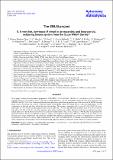The EBLM project : II. A very hot, low-mass M dwarf in an eccentric and long-period, eclipsing binary system from the SuperWASP survey
View/
Date
12/2014Author
Funder
Grant ID
ST/J001651/1
ST/I000666/1
PP/D000890/1
ST/G001006/1
PP/F000065/1
Keywords
Metadata
Show full item recordAbstract
In this paper, we derive the fundamental properties of 1SWASPJ011351.29+314909.7 (J0113+31), a metal-poor (−0.40 ± 0.04 dex), eclipsing binary in an eccentric orbit (~0.3) with an orbital period of ~14.277 d. Eclipsing M dwarfs that orbit solar-type stars (EBLMs), like J0113+31, have been identified from their light curves and follow-up spectroscopy in the course of the WASP transiting planet search. We present the analysis of the first binary of the EBLM sample for which masses, radii and temperatures of both components are derived, and thus, define here the methodology. The primary component with a mass of 0.945 ± 0.045 M⊙ has a large radius (1.378±0.058 R⊙) indicating that the system is quite old, ~9.5 Gyr. The M-dwarf secondary mass of 0.186 ± 0.010 M⊙ and radius of 0.209 ± 0.011 R⊙ are fully consistent with stellar evolutionary models. However, from the near-infrared secondary eclipse light curve, the M dwarf is found to have an effective temperature of 3922 ± 42 K, which is ~600 K hotter than predicted by theoretical models. We discuss different scenarios to explain this temperature discrepancy. The case of J0113+31 for which we can measure mass, radius, temperature, and metallicity highlights the importance of deriving mass, radius, and temperature as a function of metallicity for M dwarfs to better understand the lowest mass stars. The EBLM Project will define the relationship between mass, radius, temperature, and metallicity for M dwarfs providing important empirical constraints at the bottom of the main sequence.
Citation
Gómez Maqueo Chew , Y , Morales , J C , Faedi , F , García-Melendo , E , Hebb , L , Rodler , F , Deshpande , R , Mahadevan , S , McCormac , J , Barnes , R , Triaud , A H M J , Lopez-Morales , M , Skillen , I , Collier Cameron , A , Joner , M D , Laney , C D , Stephens , D C , Stassun , K G , Cargile , P A & Montañés-Rodríguez , P 2014 , ' The EBLM project : II. A very hot, low-mass M dwarf in an eccentric and long-period, eclipsing binary system from the SuperWASP survey ' , Astronomy & Astrophysics , vol. 572 , A50 . https://doi.org/10.1051/0004-6361/201424265
Publication
Astronomy & Astrophysics
Status
Peer reviewed
ISSN
0004-6361Type
Journal article
Rights
Reproduced with permission from Astronomy & Astrophysics, © ESO
Description
The research leading to these results has received funding from the European Community’s Seventh Framework Programme (FP7/2007-2013) under grant agreement number RG226604 (OPTICON). L.H.H. acknowledges funding support from NSF grant, NSF AST-1009810.Collections
Items in the St Andrews Research Repository are protected by copyright, with all rights reserved, unless otherwise indicated.

